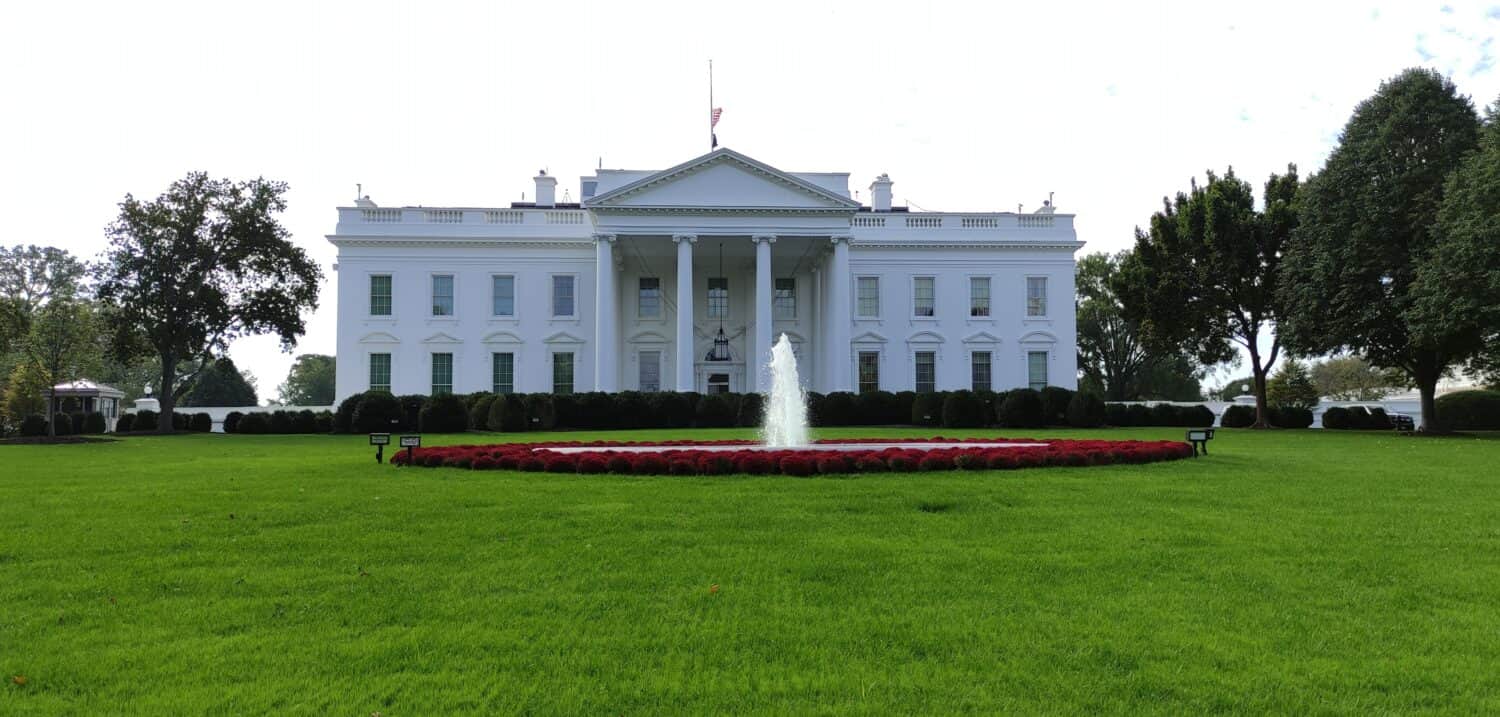Welcome to Washington, D.C., the heart of the United States, where history and democracy come alive! The Capitol Building and the White House are two of the most iconic landmarks, surrounded by various other historic sites. And getting from one to the other couldn’t be easier. Whether you opt for the convenience of public transport, the speed of a taxi, or the charm of a leisurely walk, the journey from the White House to the Capitol promises an unforgettable experience. How far is the White House from the Capitol? And what other D.C. walks should you know about? Read on to find out.
How Far Is the White House From the Capitol?

The journey from the White House to the Capitol is only a 22-minute walk, covering 2.3 miles.
©iStock.com/bloodua
The White House is 2.3 miles from the Capitol; it’s about a 22-minute walk. The White House resides at 1600 Pennsylvania Avenue, the official residence of the U.S. President. The Capitol Building stands proudly on Capitol Hill at the eastern end of the National Mall. It’s the focal point of the U.S. legislative branch.
Beyond its legislative importance, the Capitol is a treasure trove of American art. Its walls are adorned with captivating paintings and sculptures that depict the nation’s rich cultural diversity and history.
How to Get From the White House to the Capitol
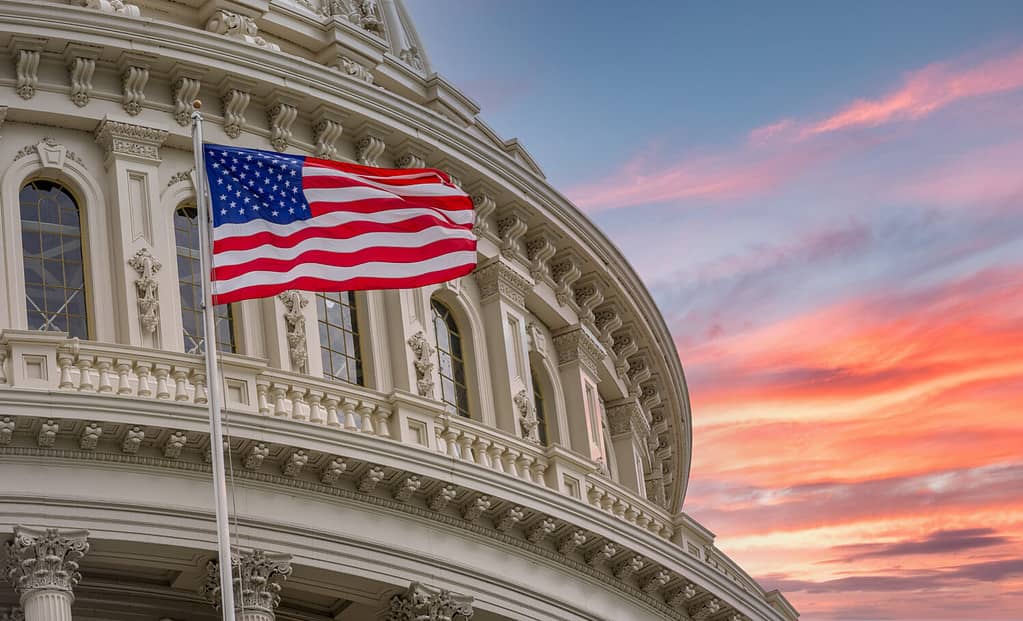
You can travel from the White House to the capitol on foot, by bus, subway, or taxi.
©tokar/Shutterstock.com
There are multiple transportation options available to explore these iconic landmarks. Choose from various means of getting around, such as:
- Bus
- Subway
- Taxi
- Walking
Need to get there quickly? A taxi ride from the White House to the Capitol can have you arriving in just around 3 minutes. It’s a convenient and direct option, but it doesn’t give you a chance to explore in the same way walking does.
For the history buffs, consider taking a leisurely walk from the White House to the Capitol. Covering around 2 miles, this 22-minute walk is worth your time. D.C. walks allow you to experience the city and discover things you might miss if you were in a car.
If walking isn’t your style, Washington, D.C., has an efficient public transportation system, making it easy to hop on a bus or the subway to reach your destination. This is an excellent option for those who want to experience the city like a local and enjoy the scenery.
Metro’s Trip Planning Tool
Preparing is easy, thanks to the transit authority’s website. The Metro’s trip planning tools offer immediate itineraries and service alerts for your trips on Metrorail and Metrobus. You can access all of the tools when checking the schedules and maps portion of their site.
The Washington Metropolitan Area Transit Authority strives to provide a smooth and organized travel experience. With approximately 823 services running weekly, you’ll have plenty of opportunities to explore the city at your own pace. Just be mindful that schedules may vary, especially on weekends and holidays. Always check schedules in advance to plan your adventure seamlessly.
Visiting the White House Visitor Center
All of the five D.C. walks below are within 1.6 miles of the White House Visitor Center, a truly exciting place to experience! The visitor center is located at 1450 Pennsylvania Ave NW, Washington, D.C. 20230. The National Park Service runs the center, and it’s been open to the public since September 2014. Admission is completely free, but you have to plan ahead. You must submit your tour request at least three weeks before your desired visit.
The center is open from Monday to Sunday, 7:30 a.m. to 4:00 p.m., but it’s closed on Federal Holidays. The grounds of President’s Park are open all year, but sometimes certain areas may be closed due to events or Secret Service operations. There are some things you can’t bring inside, like pets (except service animals)—also, no outside food or drinks. So, plan on grabbing a bite to eat before so you’re not hungry. You won’t want to leave once you’re inside the visitor center. There’s a lot to do.
The White House Visitor Center got a big makeover in 2012, thanks to a partnership with the White House Historical Association. They spent $12.6 million to make it awesome. Once you’re inside, you’ll find so much to explore. They have interactive displays, self-guided tours, multimedia shows, and over 90 artifacts from the White House collection. At the center, you can watch a special film called “The White House: Reflections from Within.” It’s all about personal stories from presidents and first ladies. Before leaving, stop by the White House Historical Association retail store for souvenirs. At the information desk, you can also ask about special ranger programs and events at President’s Park.
1. Constitution Garden
Constitution Gardens is a beautiful park in Washington, D.C., built-in 1976; the garden’s right between the Washington Monument and the Lincoln Memorial. Today, the gardens serve as an oasis in the city, offering opportunities to celebrate freedom, honor veterans, and remember presidential legacies. You can visit this beautiful park any time, as it’s open 24 hours a day. This spot has been recognized and protected as part of the National Mall and Memorial Parks.
The history of the gardens goes back much further than 1976. Step back in time to the year 1810, when the ambitious vision of the Washington Canal Company began taking shape. Over the next five years, their construction efforts culminated in opening a waterway located at the eastern end of 17th Street, where Constitution Avenue now stands. Little did they know that this initial endeavor would set the stage for the transformation of the area into something truly remarkable.
Fast forward to 1897, and the lovely Potomac Park emerges. But it wasn’t until the 1930s and 40s that a flood control levee was thoughtfully implemented. This divided the space, giving way to the distinct Constitution Gardens and the Lincoln Reflecting Pool. Then, in 1976, an inspired makeover swept through the park with the help of landscape architects. Serene lakes mirrored the lush greenery, and winding, shaded paths invited visitors to escape the busy city streets.
2. Lincoln Memorial
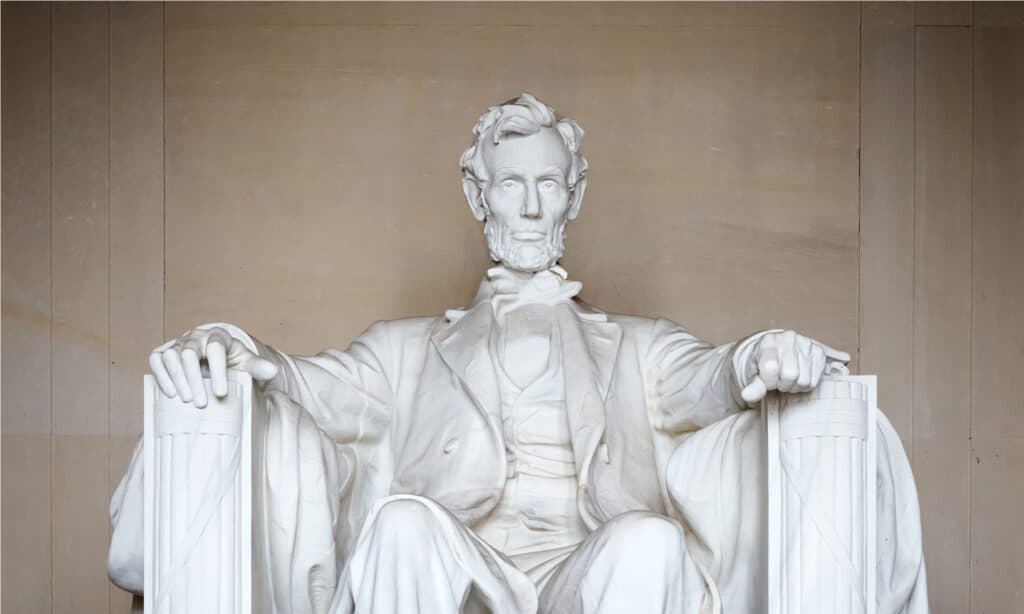
The Lincoln Memorial is open 24/7.
©S.Borisov/Shutterstock.com
Welcome to the Lincoln Memorial, a place of historical significance open to park guests 24/7, every day of the year. Abraham Lincoln, the 16th President of the United States, came from humble beginnings on the frontier. He read a lot and worked even more. Before embarking on a legal and political career, Lincoln was a store clerk, river trader, and rail splitter. Of course, the Lincoln Memorial isn’t just about Lincoln; it’s also a symbol of the United States. Almost a century old, this iconic building is recognized worldwide, serving as a backdrop for celebrations, civil rights demonstrations, and more.
Know before you go. To make the most of your D.C. walks, plan ahead! Check out the calendar on the National Mall and Memorial Parks site. The calendar is a fantastic resource for planning your visit to Washington D.C.’s historic sites. Check to see if there are any Lincoln Memorial programs or events you’d like to join.
Are you planning on exploring the National Mall and Memorial Parks with a bicycle? You’re in luck. Bicycles are welcome; there’s even designated bicycle parking near the major memorials and along the National Mall. Just avoid riding bikes within the memorials. If you have any questions, park rangers are usually available daily from 9:30 a.m. to 10 p.m. (except on December 25).
3. Thomas Jefferson Memorial

The Thomas Jefferson Memorial is surrounded by water and cherry blossom trees.
©iStock.com/Sean Pavone
Another great D.C. walk is the Thomas Jefferson Memorial. Thomas Jefferson was a multi-talented individual. He was the third President of the United States and a political philosopher, architect, musician, scientist, inventor, and more. The memorial is open 24 hours a day, so you can visit any time you want.
Located on the National Mall’s Tidal Basin, the memorial is surrounded by water and cherry blossom trees. This picturesque setting makes it especially breathtaking on moonlit nights and during the spring when cherry blossoms bloom.
The memorial itself is a stunning sight to behold. Inside, you’ll find a 19-foot bronze statue of Jefferson, symbolizing the Age of Enlightenment and its focus on liberty and equality. It’s definitely a good place to visit if you want to feel inspired. The walls are adorned with powerful words from his various texts, emphasizing the importance of religious freedom and adapting laws to changing times.
The architectural details of the memorial are just as impressive as the uplifting texts. The building is made of white marble and stands on granite and marble-stepped terraces, creating a majestic presence. Its exterior follows the White Roman style, featuring a circular colonnade of 26 Ionic columns supporting a shallow dome.
4. Washington Monument
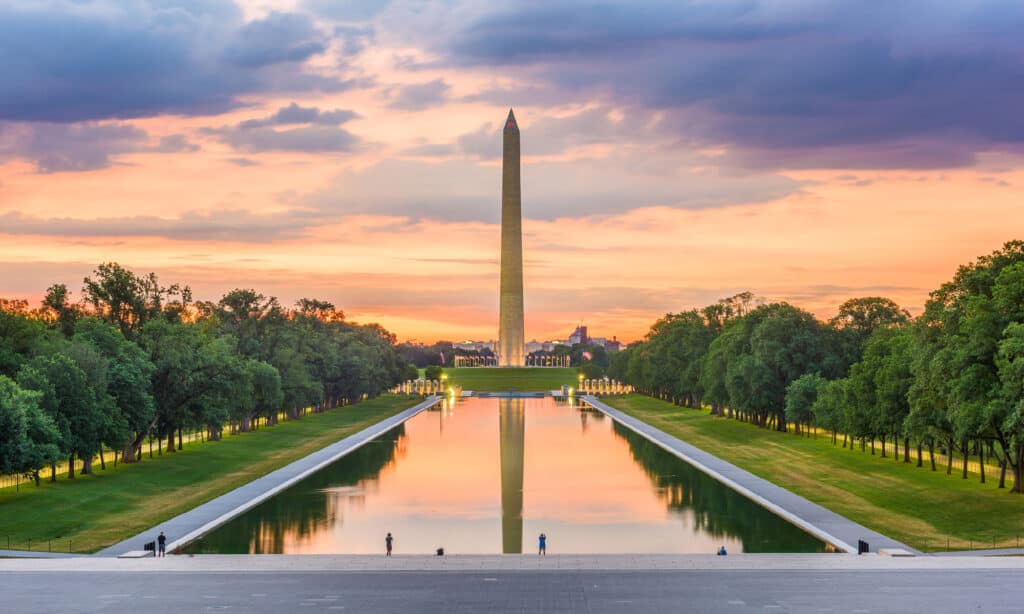
The Washington Monument is within 2 miles of the White House.
©iStock.com/Sean Pavone
The Washington Monument is a massive 555-foot marble obelisk in Washington, D.C., made to honor George Washington, the first U.S. president. The monument once held the title of the tallest building in the world.
You can visit the monument at the National Mall and Memorial Parks from 9:00 a.m. to 5:00 p.m. It’s closed one day a month for maintenance and also closes for certain holidays. Several Metro stations are nearby, like Smithsonian/National Mall, Federal Center S.W., L’Enfant Plaza, Archives-Navy Memorial, and Federal Triangle. The National Mall stretches from Capitol Hill to 14th Street, covering the Mall area, Washington Monument grounds, Tidal Basin, and West Potomac Park.
Taking the time to visit is worth the effort. The Washington Monument is a masterpiece designed by Robert Mills and completed by Thomas Casey and the U.S. Army Corps of Engineers. It was built in two phases, privately from 1848-1854 and publicly from 1876-1884. While you’re there, take the time to find the exact spot on the Lincoln Memorial steps where Martin Luther King, Jr. gave his famous “I Have a Dream” speech.
5. Martin Luther King, Jr. Memorial

The Martin Luther King, Jr. Memorial is in a lovely outdoors setting within West Potomac Park.
©iStock.com/Tim Brown
The Martin Luther King, Jr. Memorial is a special place in downtown Washington, D.C. Visiting is free, and the memorial’s available 24 hours a day. So, you can go there anytime you want. To get there from the Smithsonian Metro, take a short 15-20 minute walk along Independence Avenue to the west.
The Martin Luther King, Jr. Memorial holds a special address within West Potomac Park on 1964 Independence Avenue, S.W. These numbers represent the year when the Civil Rights Act of 1964 became law, a landmark legislation in the civil rights movement. Additionally, the official dedication date holds special meaning. The dedication date of August 28, 2011, was chosen because it’s the 48th anniversary of the March on Washington for Jobs and Freedom.
The memorial’s design resulted from a major competition, attracting over 900 applicants from 52 countries. It truly shows the global recognition of its importance. What makes it even more wonderful is that the memorial is situated in a beautiful outdoor setting, allowing you to appreciate both the monument and the surrounding nature.
Staying Safe During D.C. Walks
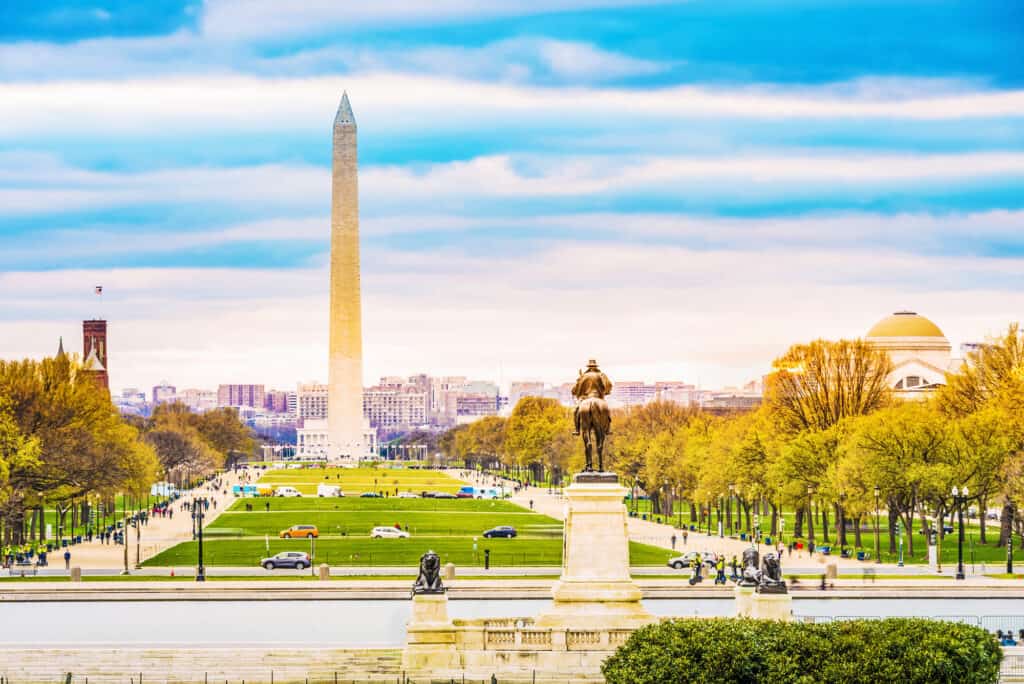
Pace yourself and drink plenty of water when you’re exploring Washington, D.C.
©iStock.com/aphotostory
If you’re planning a trip to Washington, D.C., a few safety tips can help you have a great time. For starters, plan your walks at the right time. Keep an eye on news alerts for demonstrations or potential attacks, as they can happen in the capital city. And pick the right time of year to go. While any time can be a good time to visit, consider avoiding the summer due to humidity and the winter due to blizzards. Dress accordingly for the weather, with light clothes and hats in summer and layers in winter.
Another golden rule for D.C. walks is to pace yourself and stay hydrated. It can be exciting exploring the city and all it has to offer. But you don’t want to do too much at once. There’s a lot of walking when visiting the National Mall and monuments. Follow the pathways to avoid slips. Wear comfy shoes with a good grip to prevent slipping on wet stones. Also, stay aware of your surroundings to avoid getting lost. Always stick with your group, and designate a meeting point if you get separated.
Compared to NYC, D.C.’s crime rate is higher overall, but as a tourist, you’re less likely to be affected since crime is concentrated in specific areas. Nighttime around the National Mall is usually safe since it’s busy and well-patrolled. But avoid deserted areas. As for the Metro, it’s generally safe. But it’s better to sit near the front at night and be aware of your surroundings.
Final Thoughts: D.C. Walks
The White House is about 2.3 miles from the Capitol Building. Walking takes around 22 minutes, or you can zip over there in three minutes with a taxi. D.C. also has a great public transport system with buses and subways.
Exploring Washington, D.C., offers an incredible experience filled with history, culture, and iconic landmarks. There’s so much to see and learn from the Lincoln Memorial to the Thomas Jefferson Memorial and the Washington Monument to the Martin Luther King, Jr. Memorial. And there are plenty of picture-perfect nature moments to enjoy. For instance, the Constitution Gardens, nestled between the Washington Monument and the Lincoln Memorial, offers a serene oasis. So, if you find yourself in the heart of the United States, don’t miss the chance to embark on these D.C. walks. It’ll be an experience you’ll never forget.
Thank you for reading! Have some feedback for us? Contact the AZ Animals editorial team.

